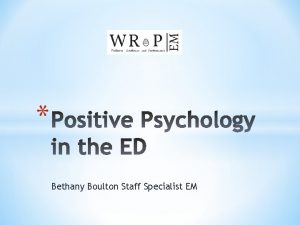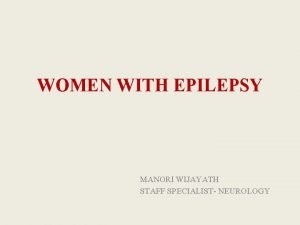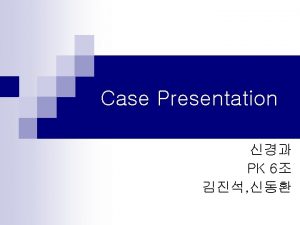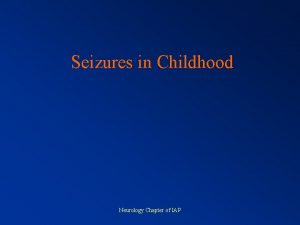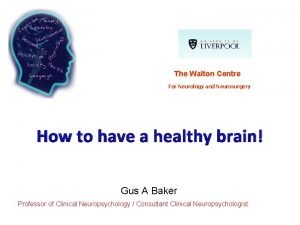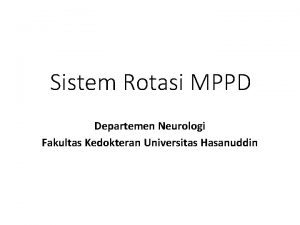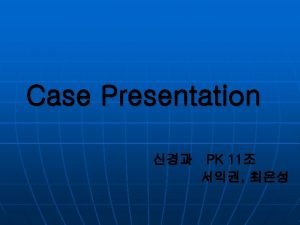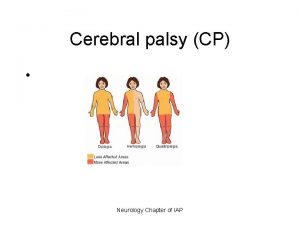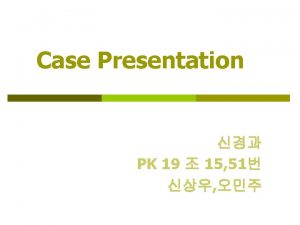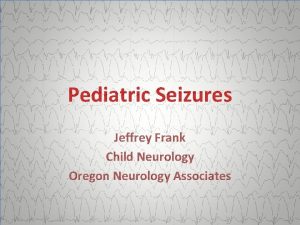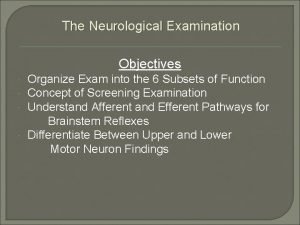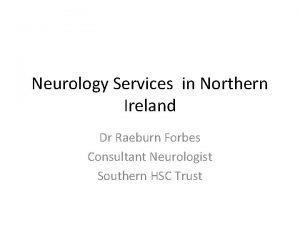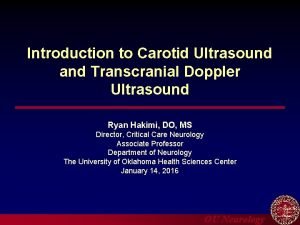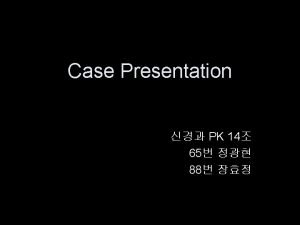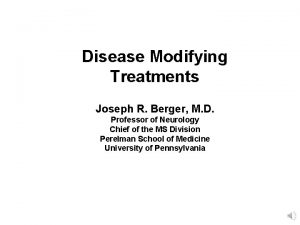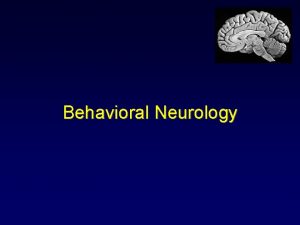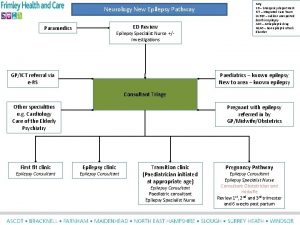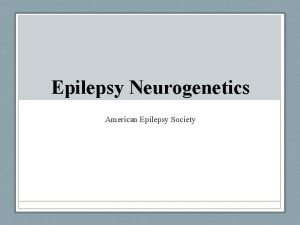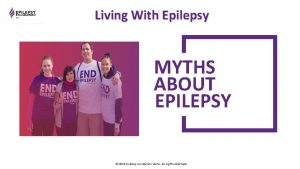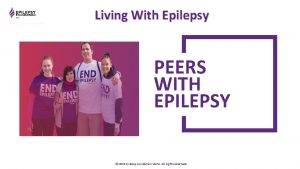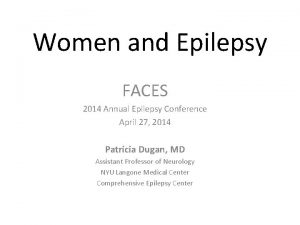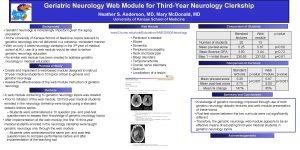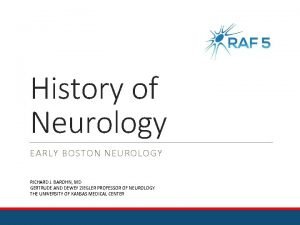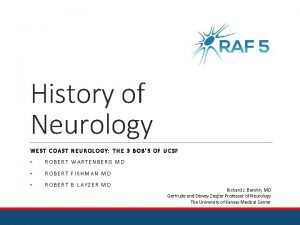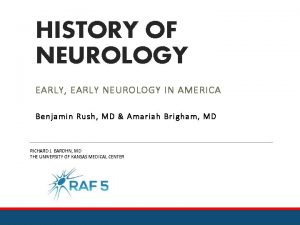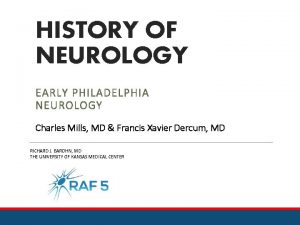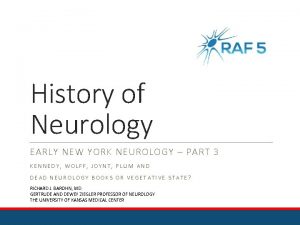WOMEN WITH EPILEPSY MANORI WIJAYATH STAFF SPECIALIST NEUROLOGY























- Slides: 23

WOMEN WITH EPILEPSY MANORI WIJAYATH STAFF SPECIALIST- NEUROLOGY

PREVALENCE OF EPILEPSY IN WOMEN • Commonest medical condition in pregnant female • USA- Year 2000, 3 -5 /1000 births are for WWE • Australia - 1500– 2000 women on AEDs become pregnant each year

WOMEN WITH EPILEPSY (WWE) • Pregnancy complications PIH, LSCS, premature labour, miscarriages, bleeding Seizure frequency and seizure freedom Management Medications medication related foetal complications • Lactation • Contraception

Seizure control and treatment changes in pregnancy: Observations from the EURAP epilepsy pregnancy registry Epilepsia, 54(9): 1621– 1627, 2013 • Prospective 3, 806 pregnancies of 3, 451 WWE on AEDs (monotherapy with CBZ, LTG, PB, VPA) Enrolment : 8. 9/40 (SD 3. 3) IGE: 39. 3%, Focal: 47. 01%, undetermined: 13. 6% • Sz Frequency Sz free: 66. 6% continuing: 33. 4% Sz freedom for at least 9 months prior to pregnancy - 84– 92% chance of remaining sz free 1 st vs 2/3 T Unchanged 70. 5% Reduction 12% Increase 15. 8%

DO WWE HAVE AN INCREASED RISK OF PREGNANCY-RELATED COMPLICATIONS? • Class I study (Viinikainen et al. , 2006)-n=179 Cesarean instrumental delivery Preeclampsia/ PIH No significantly increased risk of above BUT lack statistical precision to comment of an increased risk Premature contractions and premature labour and delivery Non smoking – no increase Smoking- substantial increase Spontaneous abortion- inadequate data

Perinatal foetal outcome with intrauterine AED exposure

Facts to remember in Rx *Altered pharmacokinetics- eg- pronounced decline in serum concentrations for AEDs eliminated by glucuronidation (UGT) *Adverse effects of AEDs on the foetus are dose-dependent (Meador et al. , 2009 a; Tomson et al. , 2011; Hernandez-Diaz et al. , 2012; ) *Aim at reducing GTCS- maternal and foetal morbidity and mortality *Review and possibly revise treatment well before conception *Titrate to the lowest effective dose before pregnancy (Harden et al. , 2009, Tomson & Battino, 2012)

free concentrations may be preferable in such situations- PHT, VPA (Johannessen & Tomson, 2006; Patsalos et al. , 2008) No Rx failures LTG, OXC, Variable, cannot predict (Tomson & Battino, 2007; Patsalos et al. , 2008 p. H, gastric emptying, intestinal motility

TREND Utilization of antiepileptic drugs during pregnancy: the EURAP registry -1999 -2005

LAMOTRIGINE • LTG clearance markedly increases in late pregnancy (Ohman et al. , 2008; Pennell et al. , 2008; Tomson et al. , 2013) § 55% protein bound § met by UGT decline markedly (50 -60%) Starts in T 1 marked in mid T 3 trimester § less pronounced when combined with VPA • Rapid return to pregnant level post delivery starts D 1 and completed in 2 to 3/52 postpartum


§ AEDs whose pharmacokinetic properties are affected, the extent variable between individuals. § Polytherapy makes it even more difficult to predict

What should we monitor? • AAN/AES guidelines

MAJOR CONGENITAL MALFORMATIONS • • • heart malformations, (VSD) orofacial defects, (cleft lip/cleft palate) urologic defects, (hypospadias) skeletal abnormalities, (radial ray defects, phalangeal hypoplasia, ) neural tube defects. (spina bifida) (Meador et al. 2008 a)

Mechanism? • Uncertain folate deficiency, ischemia, neuronal suppression, reactive intermediates (e. g. free radicals or epoxides) AED-induced neuronal apoptosis • T 1 exposure • T 3 exposure- highest risk of anatomical defects highest risk of behavioural

Anatomical terratogenesis • MCMs- 4. 5% as opposed to 2. 1% in controls • Increased risk for MCMs only with VPA(5. 6%, p = 0. 005) AED polytherapy (8. 6%, p = 0. 02) (Meador et al. 2008 a) • VPA as mono or in poly has the highest risk • dose-dependent esp VPA and LTG


Behavioural terratogenesis • WWE on RX neuronal apoptosis in neonatal rat brain -Clon, Diaz, PB, PHT, synergistic effect of two AEDs, given at below threshold dosages AEDs inherently not producing apoptosis in monotherapy, (CBZ, LTG and TPM) can enhance apoptosis induced by another • WWE no RX No difference to normal controls

Exposure to antiepileptic drugs in utero and child development: A prospective population-based study *†Gyri Veiby, ‡§Anne K. Daltveit, ¶Synnve Schjølberg, ‡¶Camilla Stoltenberg, ¶#Anne-Siri Øyen, ‡¶Stein E. Vollset, *†Bernt A. Engelsen, and *†Nils E. Gilhus Doses during pregnancy ? Sz freq in un. Rx WWE?

FOLIC ACID Insufficient data but 2 x class II studies proved benefit Recommend- 0. 4 mg, preceonception (AAN) Vit K Inadequate evidence Practise- If enzyme-inducing AEDs used, routinely receive vitamin K at delivery (AAN)

AEDs and lactation § Safe short t ½ >80% protein bound § Contraindications Long t ½- cumulative effect- sedation with BDZ High milk to plasma ratio- ETX, ZNS § Most 1 st G AEDs can be considered safe VPA, CBZ, PB, PHT, Primidone § 2 nd G AEDs- not much known clinically significant amounts in BM – LEV, LTG, OXC, TPM but therotical infant dose < therapeutic dose for neonates considered moderately safe • ***remember to drop the LTG dose, PP

AED and contraception • COCP, levenogestral implants- avoid with CBZ, PHT, PB, TPM, OXC Start with oestradiol >50 mcg/day • Preferred – intrauterine device/Depo- 10 wkly • COCP can reduce the LTG level – 25 -70%

THANK YOU Australian Pregnancy Registry
 Dr manori wijayath
Dr manori wijayath Levenogestral
Levenogestral Nlff neurology
Nlff neurology Erlanger neurology
Erlanger neurology Surgery nbme percentiles
Surgery nbme percentiles Neurology
Neurology The walton centre for neurology and neurosurgery
The walton centre for neurology and neurosurgery Mppd unhas
Mppd unhas Mary bridge pediatric neurology
Mary bridge pediatric neurology Pvnt neurology
Pvnt neurology Nlff neurology
Nlff neurology Cerebral palsy iap
Cerebral palsy iap Rrerl
Rrerl Oregon neurology associates
Oregon neurology associates Motor strength scale
Motor strength scale Nin bajaj
Nin bajaj Ulster hospital neurology consultants
Ulster hospital neurology consultants Uf neurology residents
Uf neurology residents Neurology sonography
Neurology sonography Umass memorial nurse residency program
Umass memorial nurse residency program Nlff neuro
Nlff neuro Neurology near loomis
Neurology near loomis Vanderbilt neurology residents
Vanderbilt neurology residents Joseph berger md neurology
Joseph berger md neurology
